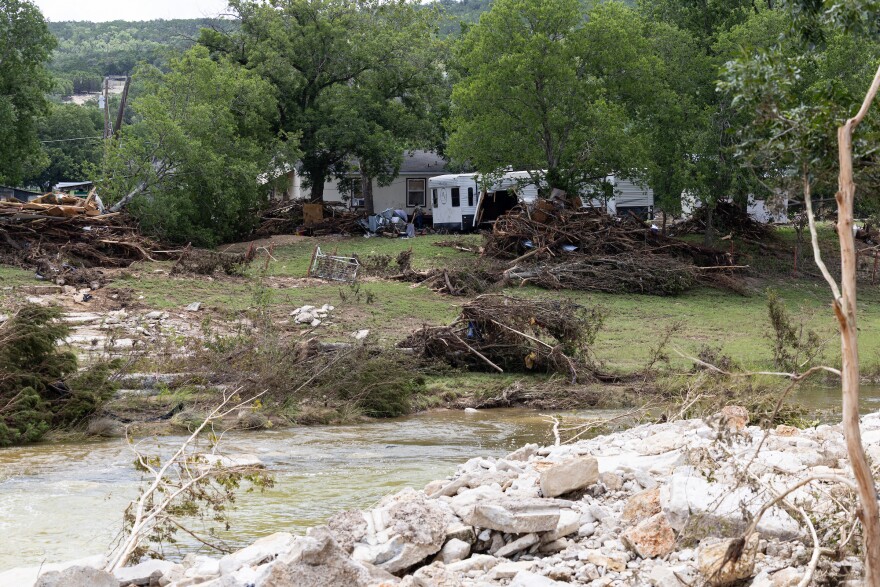Katherine Waggoner got a flood warning notification, but didn’t grasp the severity.
“The thing is, we get notifications all the time for flash floods out here. But never to this level,” she said about the catastrophic flooding that tore through the Big Sandy Creek neighborhood over the weekend. “This has never happened in this area.”
Flood watches and warnings are common in Central Texas, but it only takes a few that don't impact your safety to become numb to them. Waggoner said she’s taken them to mean low-water crossings may be dangerous.
"But for creeks to turn into raging rivers in a matter of minutes if not seconds," she said. "... it was insane."
Margie Bennight also didn’t realize how catastrophic the floods would be. She was safe in her house atop a hill on Fawn Drive, but her driveway flooded and she was trapped for two days. She’s seen intense flooding in the Big Sandy Creek neighborhood three times since she moved there in 1980, she said.
But this time was different.
“It just happened so fast,” Bennight said. “In all the time I’ve been here, I’ve never seen one that’s come in that fast.”
Others in the neighborhood, like Amber Taylor, said they didn’t get notifications until the flood was already in full force.
“About 3 o’clock in the morning is when I got the first notification of a major flood warning,” Taylor said. “And about 5 seconds after that went off, my best friend called me and said her house had been swept.”
Gaps in coverage
The National Weather Service and FEMA sent out its first Flood Warning to Travis County residents at 1:30 p.m. on July 4. More warnings continued throughout the next 24 hours.
But there’s a host of reasons why a person in Travis County might not have received those messages.
Save for weather warnings broadcast over TV news and radio stations, most emergency warnings are communicated to the public from two main agencies: WARN Central Texas and FEMA, the Federal Emergency Management Agency.

If you got a WARN notification, that means you either opted yourself into the system or WARN officials successfully tracked down your phone number and added you to its database. Martin Ritchey, head of homeland security for the Capital Area Council of Governments, said WARN alerts go to about 75% of phones in the region.
The remaining quarter of the population is, in theory, covered through FEMA alerts, which are sent through cell towers and don’t require anyone to sign up. If your phone is near a cell tower inside FEMA’s alert zone, you’ll get a notification.
But there are drawbacks to this system.
Spotty cell service can keep alerts from coming through. So can being connected to a VPN or having your phone set to “airplane mode.” Alerts can be delayed depending on what service provider you use.
People can also opt out of receiving FEMA alerts. After getting an alert that feels irrelevant, someone may have switched them off and forgotten about it, Ritchey said.
“Nobody thinks that something bad is going to happen to them,” he said. “While you’re going about your life you might get a bunch of these messages and be like ‘that’s annoying’ and turn it off and not even think about it. And then years later you’re in a different situation where something bad is happening.”
Eric Carter, Travis County’s chief emergency management coordinator, said the county will investigate in the coming weeks how effective emergency alerts were at keeping people safe.
What do different alerts mean?
Ritchey said convincing more people to sign up for WARN and not turn off notifications from FEMA could help save lives. Knowing how to interpret emergency alerts is also key. WARN doesn’t send out alerts unless they are meant to convey life-saving information, he said.
A flash flood watch means the weather conditions are favorable for heavy storms that could cause flash flooding. You don’t need to take action yet at this stage, but you should be prepared to, according to the National Weather Service.
A flash flood warning means flooding is highly likely to happen or already occurring. They are usually issued minutes to hours before flash flooding is in progress, said Charlie Woodrum, the National Weather Service's preparedness and resilience lead.
If you are in a flood-prone area, you should immediately move to higher ground. If it’s unsafe to evacuate, find a sturdy building to shelter in until the floodwaters recede, Woodrum said. Don’t drive into floodwaters, even if the water looks shallow. A vehicle can be swept away in 6 inches of floodwater.
The same guidance goes for a flash flood emergency alert, which are issued when rains are so heavy they threaten human life and can cause catastrophic damage. A flash flood emergency is what the National Weather Service issued in the Kerr County area on July Fourth and in the Austin area the following day.









